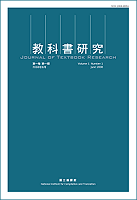|
Volume 12 Number 1
Editors: Mei-Hui Liu Ya-Hsuan Wang
|

|
|
|
|
|
|
|
Articles
Abstract | PDF Full Text | How to Cite
Content analysis of core concepts of global competence in junior high school English textbooks in Taiwan: Taking the content domains of the cognitive tests in the PISA 2018 global competence assessment as a framework
Abstract
Education for global competence has become an international trend for curriculum reform in many countries. Foreign language curricula are essential meeting points between different languages and cultures that serve as critical steps toward students attaining a global perspective. Based on the Programme for International Student Assessment (PISA) 2018 global competence framework, this study conducted a content analysis of junior high school English textbooks in Taiwan. The results revealed that content related to global competence occupied approximately 40% of the textbooks. Content related to the domain of “culture and intercultural relations” comprised 30% of the textbooks. Content related to Western cultures occupied markedly more of the textbook content than that related to non-Western cultures. Compared with previous findings on this topic, Taiwanese cultures were slightly more represented. Examples of cultural comparison were sporadically found in the textbooks. However, the subdomains of stereotypes, discrimination, and intolerance were absent. In addition to the domain of “culture and intercultural relations,” Taiwan’s English textbooks should include more content on other domains, such as “socioeconomic development and interdependence,” “environmental sustainability,” and “conflicts and human rights” for primary learning.
APA Format
Chou, P.-I., Wang, Y.-T., & Wu, S.-T. (2019). Content analysis of core concepts of global competence in junior high school English textbooks in Taiwan: Taking the content domains of the cognitive tests in the PISA 2018 global competence assessment as a framework. Journal of Textbook Research, 12(1), 1-38.
|
|
|
Abstract | PDF Full Text | How to Cite
Cultivation of intercultural competence in undergraduate students by creating an interactive e-picture book about the Misahur of the Puyuma tribe
Abstract
This study aimed to cultivate intercultural competence among nonindigenous undergraduate students in Taiwan majoring in digital media by helping them create an interactive e-picture book about the Misahur of the Puyuma tribe. The research was a type of action research; data collection included interviews, participant observation, and works analysis of the students’ e-picture book. The results revealed that the students learned most of the necessary skills of intercultural competence and demonstrated effective and appropriate communication and behavior in the intercultural situation. Only the competencies of cultural self-awareness, sociolinguistic awareness, and empathy were not completely developed. Cultivation of intercultural competence requires a longer period for instruction to explore cultural content and facilitate students’ critical reflections. Affective interaction in the intercultural situation here encouraged the students to improve their digital techniques, and through this, they learned to positively link cultivation of intercultural competence with professional development of digital media skills. Finally, this paper discusses the application of Deardorff ’s theory and suggests that picture books could be used as supplements to teaching material for indigenous schools and communities to balance the ethnic-centered perspective of current textbooks.
APA Format
Chang, J.-H. (2019). Cultivation of intercultural competence in undergraduate students by creating an interactive e-picture book about the Misahur of the Puyuma tribe. Journal of Textbook Research, 12(1), 39-68.
|
|
|
Abstract | PDF Full Text | How to Cite
Critical analysis of New Social Studies movement and its reform of teaching materials in the United States during 1950s-1970s
Abstract
The recently promulgated Curriculum Guidelines for the Social Studies Learning in Taiwan—which emphasize learner performance, activities that encourage inquiry, and hands-on learning to facilitate learner participation and independent study—bear many similarities to the New Social Studies movement in the United States between 1950s and 1970s. This study analyzed the reform of teaching materials that occurred during this movement through a thorough review of the literature. In addition to examining the movement’s origins in the Cold War and Space Race between the United States and Soviet Union alongside the fight for social science content on the school curriculum and its subsequent gradual decline caused by changes in the social trends and attitudes, this paper describes the characteristics of the New Social Studies movement, reasons for its successes and failures, and its legacy by exemplifying three selected teaching materials reform projects. The findings show that the movement has continued through several generations to the present day, indicating that cautious optimism is warranted regarding the early successes of the reform brought by the Curriculum Guidelines for Social Studies Learning in Taiwan. Finally, this paper discusses directions for possible future research and the present study’s limitations, such as the reliance on discourse over examples. Future studies on this topic should attempt to improve on these limitations.
APA Format
Shan, W.-J. (2019). Critical analysis of New Social Studies movement and its reform of teaching materials in the United States during 1950s-1970s. Journal of Textbook Research, 12(1), 69-109.
|
|
|
Froum
PDF Full Text | How to Cite
APA Format
Yang, K.-Y., Wang, L.-H., Chang, F.-M., Chen, Y.-F., & Liu, Y.-F. (2019). Forum: Digital textbooks. Journal of Textbook Research, 12(1), 111-124.
|
|
|
Book Review
PDF Full Text | How to Cite
APA Format
Lin, C.-W. (2019). Review of the book “Why won’t you just tell us the answer?”: Teaching historical thinking in grades 7-12, by Bruce A. Lesh. Journal of Textbook Research, 12(1), 125-134.
|
|
|
Manuscripts and all editorial correspondence should be sent to:
4F, 179 Sec. 1, Heping E. Rd., Daan Dist., Taipei City 106011, Taiwan (R.O.C.)
E-mail:
ej@mail.naer.edu.tw










